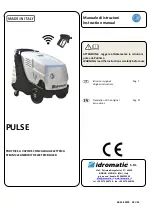
Charging Battery Pack
See Figure 3, page 9
• Charge the battery fully before first use. This will take up
to 3 hours. Due to federal regulations, the battery does
not come fully charged.
• Plug the charger into a power outlet.
• Attach the battery pack to the charger by aligning the
ribs on the battery pack to the grooves in the charger.
Slide the battery pack into the charger.
• When charging, the lights on the battery will illuminate
to show the state of charge. The light on the charger
will flash.
• If the light on the charger flashes red, there is an error
with the battery or the charger. Try again or call custom-
er service for support.
• When charge is complete the lights on the battery will
turn off and the light on the charger will be solid.
• To remove the battery pack from the charger, press the
latches and pull up on the battery pack.
Starting/Stopping the Wet/Dry Vac
See figure 4, page 9
• To start the wet/dry vac: Press the On/Off switch to the
On (|) position.
• To stop the wet/dry vac: Press the On/Off switch to the
Off (0) position.
Installing/Removing Attachements
See Figure 5, page 10
• Vacuuming can be performed with only the flexible hose
or the hose with vacuum attachments.
• Press the On/Off switch to the Off (0) position.
• Insert the attachment into the front end of the flexible
hose, making sure the attachment is firmly in place.
• To remove, hold the attachment and pull from hose.
Dry Vacuuming:
See figure 6, page 10
Vacuum only items small enough to fit through the hose or
the attachment. When dry vacuuming, make sure that the
dry use filter stays in place. The performance of the wet/
dry vac will decrease with a full collection container. When
emptying the collection container, check to see if the dry
use filter needs replacing.
NOTE: The wet/dry vac is shipped ready for dry use
vacuuming. To equip the wet/dry vac for wet use, remove
the dry use filter.
Wet Vacuuming:
See Figure 7, page 10
When wet vacuuming, be aware that your wet/dry vac is
equipped with a safety plug inside the filter unit housing.
This safety plug is designed to shut the suction off when
the collection container reaches full wet capacity. When the
collection container is full, turn the wet/dry vac off and
empty the collection container as shown in Maintenance.
• Unlock the four locking latches and remove the lid.
• Remove the dry use filter.
• Replace lid and lock securely.
OPERATION
When vacuuming liquid, make sure the product does not
get submerged or doused in liquid, which could cause
shock, vacuum failure, or personal injury.
General Maintenance
Avoid using solvents when cleaning plastic parts. Most
plastics are susceptible to damage from various types of
commercial solvents and can be damaged by their use. Use
clean cloths to remove dirt, dust, oil, grease, etc.
This product contains no serviceable parts.
If appliance is not working as it should, has been dropped,
damaged, left outdoors or dropped in water, contact customer
service at 800-406-2005.
Removing Waste from the Collection Container
See Figure 8 & 9, page 10
The collection container should be checked, emptied, and
cleaned periodically to obtain maximum efficiency.
Dry waste:
• Remove the battery pack.
• Unlock the locking latches and remove the lid.
MAINTENANCE
Do not at any time let brake fluids, gasoline, petroleum-
based products, penetrating oils, etc., come in contact with
plastic parts. Chemicals can damage, weaken or destroy
plastic which could result in serious personal injury.
WARNING!
WARNING!
In low relative humidity conditions, vacuuming fine
debris with the wet/dry vac can cause a static charge
resulting in static shock. To reduce static shock while
using, add moisture to the air with a humidifier.
WARNING!
PG.6
Содержание ONEPWR HAND VACUUM
Страница 28: ...Notes ...
Страница 29: ......








































